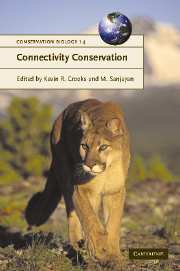Book contents
- Frontmatter
- Contents
- List of contributors
- Acknowledgements
- 1 Connectivity conservation: maintaining connections for nature
- PART I Approaches to connectivity research
- PART II Assessing connectivity
- PART III Challenges and implementation of connectivity conservation
- Introduction: Don't fence me in
- 18 Hyperconnectivity, invasive species, and the breakdown of barriers to dispersal
- 19 Disease and connectivity
- 20 Maintaining and restoring connectivity in landscapes fragmented by roads
- 21 Where to draw the line: integrating feasibility into connectivity planning
- 22 South Coast Missing Linkages: restoring connectivity to wildlands in the largest metropolitan area in the USA
- 23 Incorporating connectivity into broad-scale conservation planning
- 24 Escaping the minimalist trap: design and implementation of large-scale biodiversity corridors
- 25 The role of connectivity in Australian conservation
- 26 The future of connectivity conservation
- Index
- References
19 - Disease and connectivity
Published online by Cambridge University Press: 24 May 2010
- Frontmatter
- Contents
- List of contributors
- Acknowledgements
- 1 Connectivity conservation: maintaining connections for nature
- PART I Approaches to connectivity research
- PART II Assessing connectivity
- PART III Challenges and implementation of connectivity conservation
- Introduction: Don't fence me in
- 18 Hyperconnectivity, invasive species, and the breakdown of barriers to dispersal
- 19 Disease and connectivity
- 20 Maintaining and restoring connectivity in landscapes fragmented by roads
- 21 Where to draw the line: integrating feasibility into connectivity planning
- 22 South Coast Missing Linkages: restoring connectivity to wildlands in the largest metropolitan area in the USA
- 23 Incorporating connectivity into broad-scale conservation planning
- 24 Escaping the minimalist trap: design and implementation of large-scale biodiversity corridors
- 25 The role of connectivity in Australian conservation
- 26 The future of connectivity conservation
- Index
- References
Summary
INTRODUCTION
Fragmentation of natural habitats has important effects on the viability and persistence of most free-living animal and plant species; the other chapters in this volume outline many of these effects in eloquent detail. In this chapter we focus our attention on the parasitic half of biodiversity and examine how the viability and persistence of pathogens and parasitic species are modified by fragmentation and reconnection of the patchy habitats in which their host species live. The problem can be addressed at a hierarchy of different scales, as almost by definition, parasites and pathogens are canonically “adapted” to live in the patchy environment defined by the individual hosts they live in (Dobson 2003). Life-history evolution in parasites is sharply defined by the twin processes of exploiting the patch of habitat in which you live (your host) and producing infective stages (your offspring), which have to then find new patches (hosts) to exploit. Movement between hosts for pathogens is similar in many ways to dispersal between patches for free-living organisms. The key difference is that all of the dispersal in pathogens is undertaken by transmission stages that are the effective offspring of the parasites that currently infect the host. So transmission between host patches is for parasites both birth and dispersal. Fragmentation of the host's habitat increases the average distances the parasites have to move between birth and successful colonization.
- Type
- Chapter
- Information
- Connectivity Conservation , pp. 479 - 501Publisher: Cambridge University PressPrint publication year: 2006
References
- 5
- Cited by



